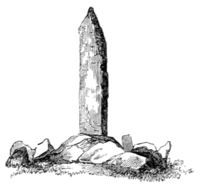instances they may have been erected m memory of some engagement at sea.
The tall narrow standmg stones termed "Bautastene," or memorial stones, were unquestionably, as the name indicates, memorials; they are usually from nine to twenty feet long, and stand in the middle or at the side of the barrow. At Stenehede in Bahuslehn are seen nine entire bauta-stones, and three which have been split in two, in a row fifty paces long, between oval and round barrows. But still more remarkable is the field of battle situated not far from the above at Gresby, in the parish of Tamune, where, in a short space, about a hundred and thirty very low barrows, partly round, partly oval, and surrounded with stones, occur, of which about fifty appear to have been adorned with standing stones, from seven to fifteen feet in length. There are about forty of these stones remaining, but only sixteen stand erect[1].
- ↑ The subjoined woodcut, reduced from a lithographic print in the larger work by Mr. Worsaae, mentioned in the preceding note, represents a view of a number of bauta-stones now existing at Hiortehammar.—T.
Vikings into something like a certainty; and to confirm the assertion of the Sagas, that the bodies of these heroes were first burnt in their ships — that the ashes were then covered with earth, and the grave encircled with stones in the form of a ship.—T.


